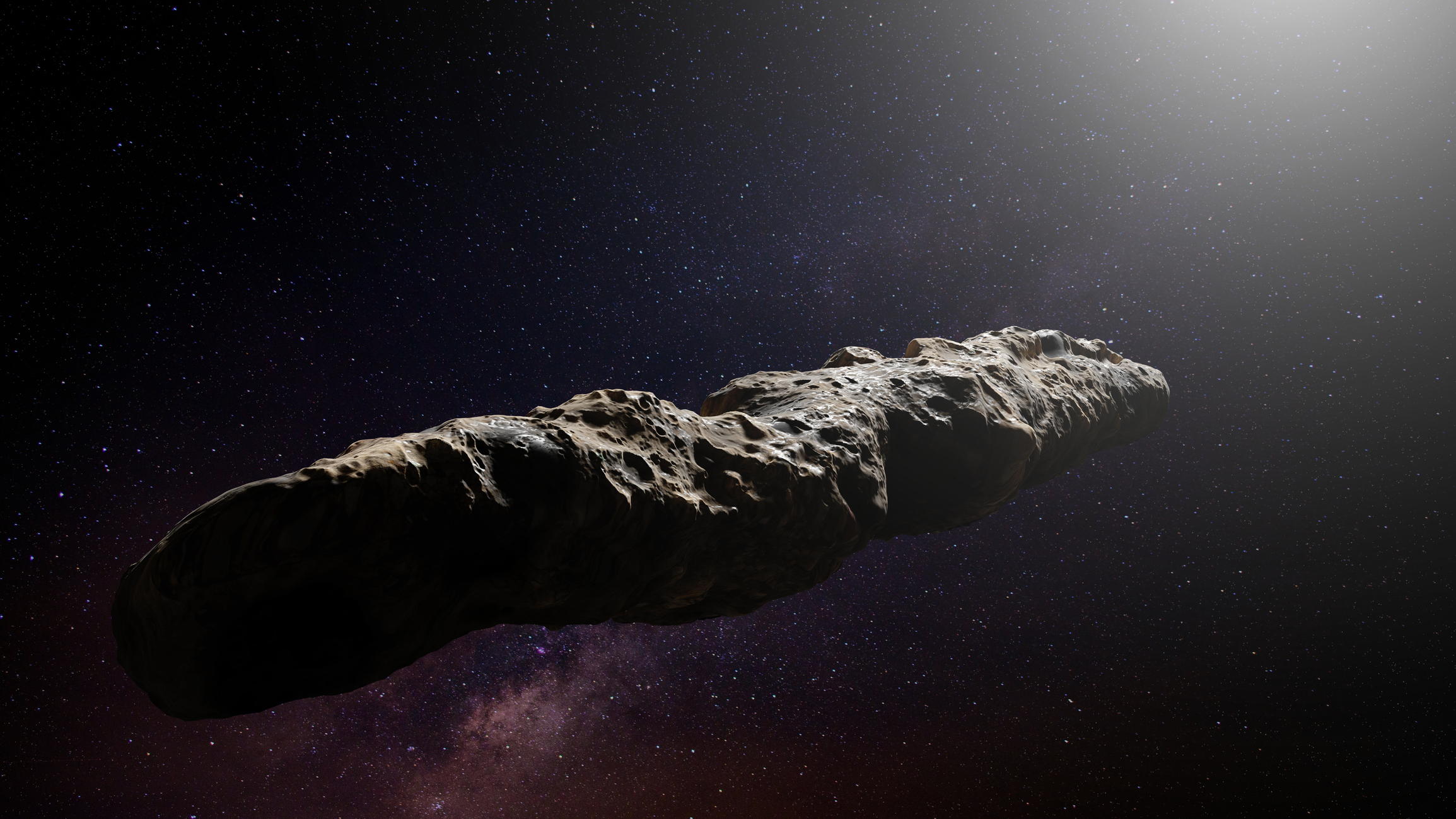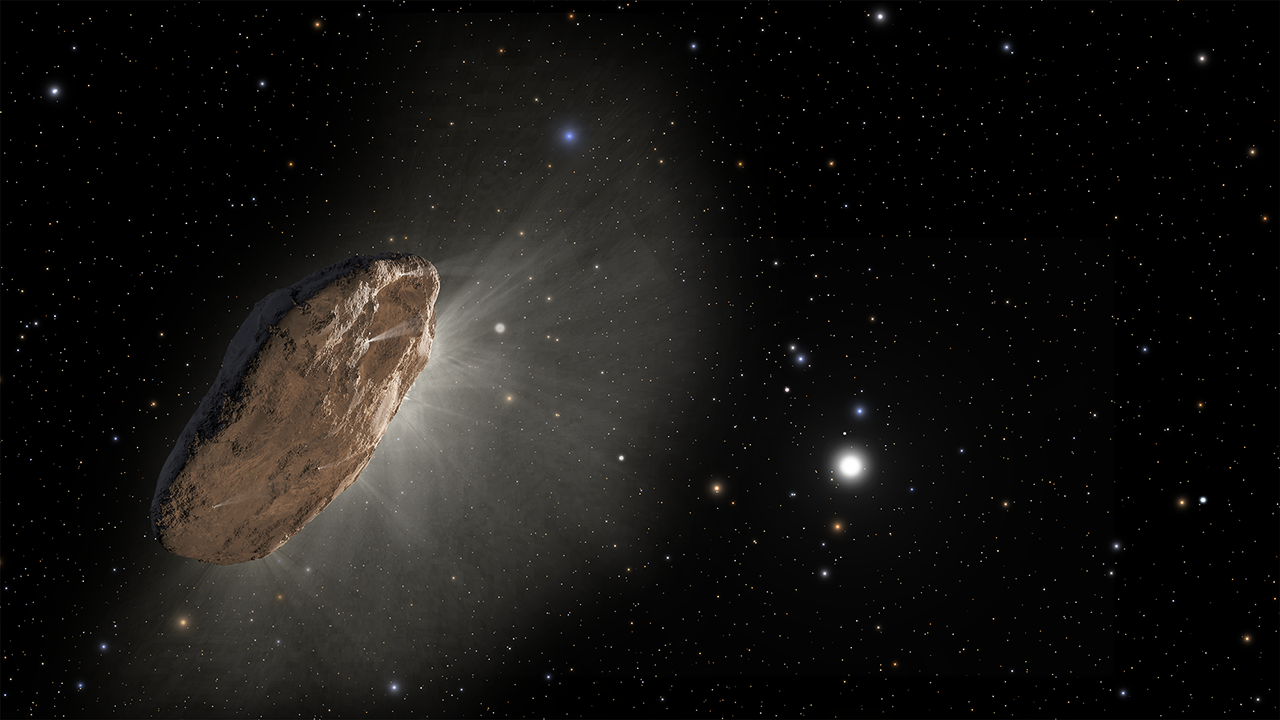'Oumuamua: A guide to the 1st known interstellar visitor
What was the interstellar object 'Oumuamua, where did it come from, and where is it going?

1I/'Oumuamua was a small object that came from interstellar space and passed close to the sun as it traveled through the inner solar system in the autumn of 2017. It was notable because it was the first confirmed object to have come from a planetary system beyond our own.
Astronomers designated it 1I/'Oumaumua, with the "1I" referring to it being the first interstellar object discovered in our solar system, though the name is now commonly shortened to 'Oumuamua.
Astronomers had been waiting a long time for an interstellar object like 'Oumuamua to come along. "For decades, we've theorized that such interstellar objects are out there, and now — for the first time — we have direct evidence they exist," Thomas Zurbuchen, NASA's associate administrator for science when 'Oumaumua was discovered, said in 2017.
In August 2019, a second interstellar object, named 2I/Borisov, was found in the solar system. However, Borisov looked like a normal comet, with a coma (the gaseous "head' around a comet's icy nucleus) and a tail. In comparison, 'Oumuamua was very unusual because it lacked a coma or a tail.
Related: 15 stunning places on Earth that look like they're from another planet
'Oumuamua FAQs
What is the mystery of 'Oumuamua?
Interstellar objects were predicted to exist long before 'Oumuamua was discovered. However, 'Oumuamua wasn't what astronomers were expecting. Small and unusually shaped, it didn't look like a comet, yet it moved as though it were outgassing. The leading theories involve the sublimation of either nitrogen or hydrogen ice. There is no evidence that 'Oumuamua was a spaceship.
What made 'Oumuamua so interesting?
Interstellar objects come from other planetary systems and are thrown into interstellar space either by giant collisions that smash protoplanets apart or by the gravitational tides of marauding gas giant planets. As the first interstellar visitor to have been identified, 'Oumuamua gives us insight into what other extrasolar planetary systems might be like.
Why is it named 'Oumuamua?
Its name is the Hawaiian word for "a messenger from afar arriving first" — very fitting for the first interstellar object to be discovered in our solar system. A Hawaiian name was chosen because the telescope that discovered it — PanSTARRS-1 — is based in Hawaii.
What was 'Oumuamua's size and shape?
'Oumuamua's shape was also notable. Initial measurements suggested that the object was shaped like a long cylinder with a size ratio of 10:1, meaning it was 10 times as long as it was wide. However, astronomers later revised these dimensions to approximately 6:6:1, which instead describes a pancake shape. Astronomers have seen similarly shaped objects in the Kuiper Belt beyond Neptune — specifically, a minor planet called Arrokoth, which NASA's New Horizons spacecraft flew past on New Year's Day 2019. The measurements of 'Oumuamua's shape and dimensions were based on its "light curve," a graph that tracks how the object's brightness changed over time as it tumbled through space. 'Oumuamua appeared brighter when we saw its broader side.
'Oumuamua was also very small, estimated to be 377 feet (115 meters) long, 364 feet (111 m) wide and 62 feet (19 m) thick, based on it having an albedo of 0.1 (meaning it reflected 10% of sunlight falling on it, which is fairly standard for a cometary nucleus).
Breaking space news, the latest updates on rocket launches, skywatching events and more!
Where did 'Oumuamua come from?
Nobody knows which star system 'Oumuamua originated from. However, in 2018, astronomers tracked 'Oumuamua back along the path from which it first approached the sun and found that the object passed near four stars, coming closest to the red dwarf star HIP 3757 a million years ago. Perhaps 'Oumuamua came from there, or maybe it has been wandering space for much longer.
Planets, asteroids and comets in our solar system orbit the sun in closed loops. 'Oumuamua's trajectory was different: A NASA animation describes how the object's path was hyperbolic, meaning it came hurtling toward the sun fast enough that the sun's gravity could bend 'Oumuamua's path only slightly, rather than capturing it in a looping orbit. This meant that 'Oumuamua, which was traveling at 16.36 miles per second (26.33 kilometers per second) relative to the sun's motion, could just keep on going, heading toward the solar system's exit door.
Where is 'Oumuamua now?
Astronomers didn't spot 'Oumuamua until after it had made significant inroads into our solar system. It reached perihelion — its closest point to the sun — on Sept. 9, 2017, when it got as close as 23 million miles (37 million kilometers) to our star. It wasn't until over a month later, on Oct. 19, 2017, that University of Hawaii astronomer Rob Weryk discovered 'Oumuamua in observations made by the asteroid-hunting Panoramic Survey Telescope and Rapid Response System (Pan-STARRS). At that time, 'Oumuamua was 21 million miles (33 million km) from Earth, and its trajectory eventually brought it as close as 15 million miles (24 million km).
Ever since then, the interstellar visitor has been heading out of the solar system, with NASA describing how 'Oumuamua was accelerated by a gravity assist from the sun to a velocity of 54.2 miles per second (87.3 km/s). Given how small 'Oumuamua is and how fast it was moving away from us, the window for observing it was just a few weeks, with the Hubble Space Telescope able to track it the longest. The best images of 'Oumuamua — such as this one made by combining data from the Very Large Telescope and the Gemini South telescope, both of which are in Chile and are among the largest optical telescopes in the world — could show 'Oumuamua as only a speck of light.
'Oumuamua is heading toward the constellation Pegasus and is now far beyond the orbit of Neptune. It is passing through the Kuiper Belt, a ring of icy bodies near the edge of the solar system, and is now beyond the reach of our telescopes. It will never come back toward Earth.
What was 'Oumuamua?
There are several hypotheses as to what 'Oumuamua was. We know that it was an object ejected from an extrasolar planetary system when the gravitational tides of marauding gas giants shook 'Oumuamua free from its orbit.
Before 'Oumuamua was discovered, astronomers expected interstellar objects to be comet-like, which ended up being the case for 2I/Borisov. At first, when 'Oumuamua didn't sprout a cometary tail, astronomers thought the interstellar interloper must be a dead comet whose volatiles — gases with low boiling points, such as water — sublimated away over billions of years, perhaps when it was still in its system of origin or when it passed close to other stars.
However, the Hubble Space Telescope measured that 'Oumuamua's outward trajectory from the sun displayed some nongravitational acceleration. This is typical behavior for comets, as the ejection of dust and water vapor from a comet in a tail gives the comet an extra push. But no outgassing of water or other volatile gases expected on comets was detected coming from 'Oumuamua.
There are two leading explanations for what 'Oumuamua could be. One, from Alan Jackson and Steve Desch of Arizona State University, proposes that 'Oumuamua is a chunk of nitrogen ice. When New Horizons flew past Pluto in 2015, it observed areas, such as Sputnik Planitia, that were essentially frozen nitrogen lakes; Jackson and Desch suggested that 'Oumuamua could be a fragment of nitrogen ice that a giant impact blasted off of a Pluto-like body. Outgassing nitrogen, sublimated by the heat of the sun, would have given 'Oumuamua the necessary extra push. Nitrogen also would have given 'Oumuamua an albedo of 0.64, which is more reflective than a typical comet, so 'Oumuamua would have had to be smaller than thought to have appeared so faint. Jackson and Desch calculated that if 'Oumuamua was made from nitrogen ice, the object's dimensions would be just 148 by 144 by 25 feet (45 by 44 by 7.5 m).
Another possible explanation, proposed by Darryl Seligman of Cornell University and Jennifer Bergner of the University of California, Berkeley, is that while 'Oumuamua was traveling through interstellar space, cosmic rays might have interacted with ice on the surface, liberating the hydrogen from some of the water molecules and creating a supply of hydrogen gas locked up in amorphous water-ice. Per Seligman and Bergner's hypothesis, when 'Oumuamua passed by the sun, the interstellar object was heated, though not enough to cause the water ice to evaporate. Instead, the heating changed the structure of the ice crystals, thus allowing the hydrogen to escape at a rate of 0.4 to 28 ounces per second (10 to 800 grams per second) and giving 'Oumuamua the observed push. This would also explain why 'Oumuamua had no visible dust tail, because the dust would have still been trapped in the water ice.
Was 'Oumuamua a spaceship?
A hypothesis put forward by Harvard astronomers Avi Loeb and Shmuel Bialy proposes that the nongravitational acceleration is evidence that 'Oumuamua was a spaceship with a solar sail. However, most astronomers do not support this theory. Desch, Jason Wright of Penn State University and Sean Raymond of the University of Bordeaux in France criticized this proposal in an article for Medium and concluded that there is no evidence that 'Oumuamua was a spaceship.
'Oumuamua Q&A with an expert
We interviewed David Trilling, a professor in the Department of Astronomy and Planetary Science at Northern Arizona University, about how many other objects like 1I/'Oumuamua might be out there.
You previously predicted that we would find an average of one interstellar object in our solar system every five years. We've found two so far. Would you agree that this is consistent with your prediction?
Yes, I would, especially because after 'Oumuamua and Borisov, it's been pretty quiet on the interstellar-object-discovery front. So that's two objects since 2017 — two in six years. We argued that "current capabilities" started in perhaps 2015 — that's the current (pre-Rubin Observatory) set of discovery telescopes. So, two objects in eight years is, for astronomers, very close to one every five years.
You based that prediction on the assumption that 20 Earth masses of material gets kicked out of each planetary system as it forms. That's a huge amount — is it all in the form of 'Oumuamua-size objects?
Well, maybe. In that paper, we made a lot of assumptions and extrapolations to attempt to use a single object to understand something universal about planetary system formation and evolution. So, the numbers and conclusions we drew are very uncertain — perhaps as good as an order of magnitude, and perhaps not even that good! Back to the question: Various evolutionary models of our solar system, which are based on several lines of evidence, suggest that our solar system ejected many Earth masses of material in its early stages. If young systems near us ejected 20 Earth masses of material on average, that may not be too different from what happened in our solar system. It actually would be more interesting if the typical number for other systems near us was a lot more, or a lot less, than what our solar system experienced, because that might imply that there is
something strange about us. Instead, we might be typical, which is really the kind of result you'd expect. Also, remember that Jupiter has a mass of 318 Earths. In this context, 20 Earth masses is maybe not that much compared to the planets of our solar system — it's just a tiny fraction of the overall mass of our solar system. Would it all be in 'Oumuamua-sized bodies? Well, who knows. Most things in the universe obey some kind of power law distribution, where there are a small number of large members of the group and a lot of small members. Maybe 'Oumuamua is somewhere in the middle. We really have no idea.
How many interstellar objects could be passing through the solar system at any one time?
There are some estimates that there are between 1,000 and 10,000 interstellar objects in the solar system at any one time — wow! Of course, almost all of these are in the distant solar system, and we'd never be able to see them. You might roughly guess that these objects more or less appear to be coming from the direction in which our solar system is moving through space, in the same way that when you are driving in the rain, all the raindrops look like they are coming straight toward your windshield.
Additional resources
'Oumuamua was discovered by the Pan-STARRS observatory, which hunts for asteroids and comets, some of which may be potentially hazardous to Earth. Later this decade, the Vera C. Rubin Observatory will come online and is expected to detect an average of one interstellar object per year. Read more about how the observatory will do this with this informative NOIRLab article. 'Ourmuamua isn't the only interstellar visitor. You can read more about the naming of 2I/Borisov in this International Astronomical Union press release.
Bibliography
NASA Solar System Exploration: 'Oumuamua, https://solarsystem.nasa.gov/asteroids-comets-and-meteors/comets/oumuamua/in-depth/
Jonathan O'Callaghan, Mystery if our First Interstellar Visitor May be Solved, Science, 2023, https://www.science.org/content/article/mystery-our-first-interstellar-visitor-may-be-solved
Sergey Mashchenko, Modelling the Light Curve of 'Oumuamua: Evidence For Torque and Disc-Like Shape, Monthly Notices of the Royal Astronomical Society, 2019, https://academic.oup.com/mnras/article/489/3/3003/5556541
Coryn A. L. Bailer-Jones et al, The Astronomical Journal, 18 October 2018, https://iopscience.iop.org/article/10.3847/1538-3881/aae3eb
Karen J. Meech at al, A Brief Visit From a Red and Extremely Elongated Interstellar Asteroid, Nature, 2017, https://www.nature.com/articles/nature25020
NASA, Small Asteroid or Comet 'Visits' from Beyond the Solar System, 2017, https://www.nasa.gov/feature/jpl/small-asteroid-or-comet-visits-from-beyond-the-solar-system
European Southern Observatory, ESO Observations Show First Interstellar Asteroid is Like Nothing Seen Before, 2017, https://www.eso.org/public/news/eso1737/
European Space Agency, Hubble Sees 'Oumuamua Getting a Boost, 2018, https://esahubble.org/news/heic1813/
Alan P. Jackson and Steven J. Desch, 1I/'Oumuamua as an N2 Ice Fragment of an Exo-Pluto Surface: I. Size and Compositional Constraints, JGR Planets, 2021, https://agupubs.onlinelibrary.wiley.com/doi/full/10.1029/2020JE006706
S. J. Desch and A. P. Jackson, 1I/'Oumuamua as an N2 Ice Fragment of an Exo-Pluto Surface: II. Generation of N2 Ice Fragments and the Origin of 'Oumuamua, 2021, https://agupubs.onlinelibrary.wiley.com/doi/full/10.1029/2020JE006807
Jennifer B. Bergner and Darryl Seligman, Acceleration of 1I/'Oumuamua From Radiolytically Produced H2 in H20 Ice, Nature, 2023,
https://www.nature.com/articles/s41586-022-05687-w
Shmuel Bialy and Abraham Loeb, Could Solar Radiation Pressure Explain 'Oumuamua's Peculiar Acceleration? The Astrophysical Journal Letters, 2018, https://iopscience.iop.org/article/10.3847/2041-8213/aaeda8
Jason T. Wright, Steven Desch, Sean Raymond, 'Oumuamua: Natural or Artificial?, Medium, 2013, https://medium.com/@astrowright/oumuamua-natural-or-artificial-f744b70f40d5
David E. Trilling et al, Implications for Planetary System Formation From Interstellar Object 1I/2017U1 ('Oumuamua), The Astrophysical Journal Letters, 30 November 2017, https://iopscience.iop.org/article/10.3847/2041-8213/aa9989

Keith Cooper is a freelance science journalist and editor in the United Kingdom, and has a degree in physics and astrophysics from the University of Manchester. He's the author of "The Contact Paradox: Challenging Our Assumptions in the Search for Extraterrestrial Intelligence" (Bloomsbury Sigma, 2020) and has written articles on astronomy, space, physics and astrobiology for a multitude of magazines and websites.

